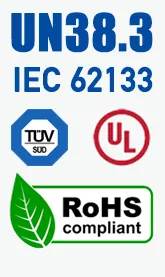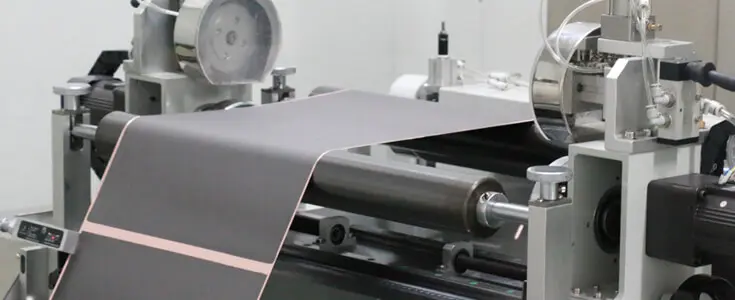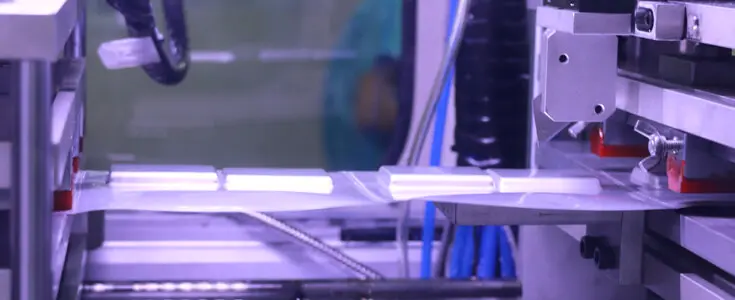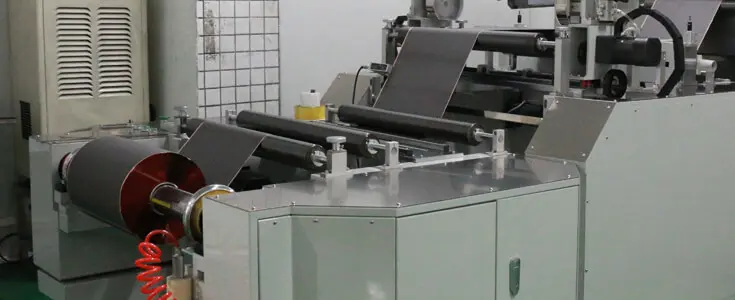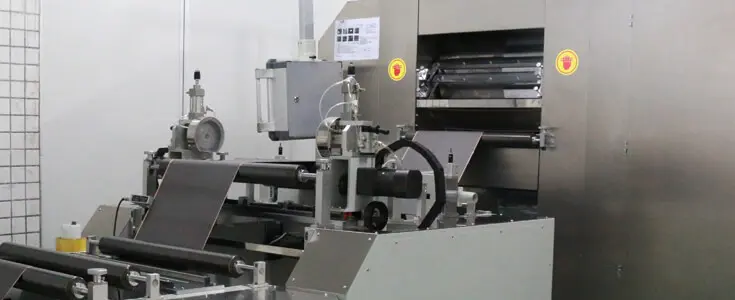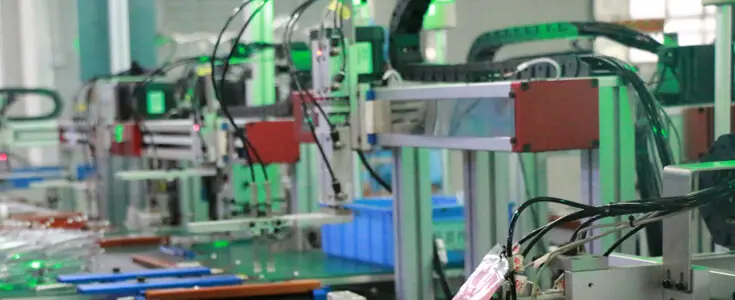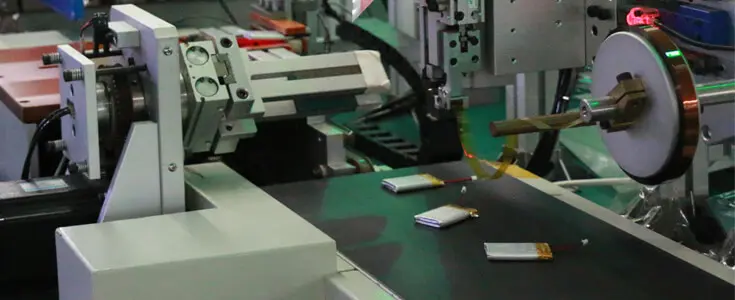UL1642 Certification of Lithium-ion Battery
What's UL1642 certification? What's UL1642 standard for lithium-ion battery? What's the test items of UL1642 certification? You can find all answers here!
UL1642 certification requirements cover rechargeable lithium-ion batteries for use as a power supply in the products. These lithium-ion batteries contain metallic lithium, a lithium alloy. They may consist of a single electrochemical cell or two or more cells connected in parallels or series, or both, that convert chemical energy into electrical energy by an irreversible or reversible chemical reaction.
UL1642 certification requirements cover lithium-ion batteries intended for use in technician-replaceable or user-replaceable applications.
UL1642 certification requirements are made for avoiding the risk of fire or explosion when lithium-ion batteries are working in a product. The final acceptability of these lithium-ion batteries is dependent on their use in a complete product that complies with UL1642 certification applicable to such products.
UL1642 certification requirements are also intended for avoiding the risk of injury to persons due to fire or explosion when user-replaceable lithium-ion batteries are removed from a product and discarded.
UL1642 certification requirements cover technician-replaceable lithium-ion batteries that contain 5.0g or less of metallic lithium. A lithium-ion battery containing more than 5.0g of lithium-ion is judged based on compliance with the requirements in this UL1642 standard, insofar as they are applicable, and further examination and test to determine whether the lithium-ion battery is acceptable for its intended uses.
UL1642 certification requirements cover user-replaceable lithium-ion batteries that contain 4.0g or less of metallic lithium-ion with not more than 1.0g of metallic lithium in each electrochemical cell. A lithium-ion battery is holding more than 4.0g or a cell containing more than 1.0g lithium-ion may require further examination and test to determine whether the cells or batteries are acceptable for their intended uses.
UL1642 certification requirements do not cover the toxicity risk that may result from the ingestion of a lithium-ion battery or its contents, nor the risk of injury to persons that may occur if a lithium-ion battery is cut open to provide access to the metallic lithium.
All Test Items of UL 1642 Certification
T.10 Short-Circuit Test
T.11 Abnormal Charging Test
T.13 CrushTest
T.14 ImpactTest
T.15 Shock Test
T.16 Vibration Test
T.17 Heating Test
T.18 Temperature Cycling Test
T.19 Low Pressure (Altitude Simulation) Test
T.20 Project Test
1. Description of the lithium-ion battery
The tested sample of lithium-ion batteries is created with only one single lithium-ion cell and doesn’t have any over current and short- circuits.
1) These tested lithium-ion cells have not been evaluated in combination with charger or host products. Additional evaluation to determine compliance may be required on the combinations in the end product evaluation.
2) The tested lithium-ion cells were evaluated for maximum voltage limit outlined and charge current and in the table below. The end product evaluation shall ensure that current and voltage limits noted are maintained.
3) The tested lithium-ion cell shall be fixed in a case with sufficient protective strength as a mechanical enclosure and fire enclosure. The end product shall keep away from fire and high-temperature areas.
2. General of UL1642 Certification
2.1 Units of measurement
2.1 Terminology
2.3 Components
3. Glossary of UL1642 Certification
4. The General of UL1642 Certification4.1.1
The casing of a lithium-ion battery shall have the power and rigidity necessary to resist the abuses to which it may be subjected, without resulting in a risk of fire. The casing of a user-replaceable lithium battery shall have the strength and rigidity necessary to resist the abuses to which it may be subjected without resulting in a risk of injury to persons.
4.1.2
A lithium-ion cell of a user-replaceable battery shall be in a hard casing of adequate strength to prevent flexing. A tool providing the mechanical advantage of pliers, screwdriver, or hacksaw shall be the minimum capable of opening the user-replaceable cell casing if the opening of the housing will expose metallic lithium.
4.2.1
A user-replaceable battery shall not contain pressurized vapor or liquid that could spray materials into the eyes or leak more than 5 milliliters of liquid when the battery casing is punctured under standard laboratory conditions, 23 ±2°C (73 ±3.6°F).
4.3.1
A lithium-ion battery shall be protected from abnormal charging currents during use. A lithium-ion battery tested and found satisfactory for the charging current, IC, MOS, under fault conditions specified by the battery manufacturer. The lithium-ion battery shall be protected from high charging currents in the end product application by two blocking parts, such as diodes, or one blocking parts, and one current limiting component, such as a resistor or a fuse.
The charging current limiting component shall limit the charging current to one-third of the value used in the abnormal charging test.
5. The Performance of UL1642 Certification
5.1.1
Technician-replaceable lithium-ion cells or lithium-ion batteries are to be tested as described in Sections 10 – 20. Section 12, forced-discharge test, applies only to cells intended to be used in series-connected multicell applications such as lithium-ion battery packs.
5.1.2
When a fire or explosion occurs as a result of the crash test, section 13, or the impact test, Section 14, or the lithium-ion cell or lithium-ion battery ruptures to the extent that the aluminum test cage is penetrated during the projectile test, section 20; the use of the technician replaceable cell or battery shall be restricted to applications in which it is not exposed to or is protected from, any conditions shown to cause a fire or explosion.
5.1.3
Lithium-ion cells and lithium-ion batteries subjected to the shock test, section 15, vibration test, section 16, temperature cycling test, section 18, and low-pressure test, Section 19, shall also not leak or vent. For these tests, unacceptable leakage is determined to have happened when the resulting mass loss exceeds the values shown in table 5.1, venting, and leakage mass loss measures.
5.2.1
The user-replaceable lithium-ion cells or lithium-ion batteries are to be tested, as described in sections 10-20. Section 12, a forced discharge test, applies only to lithium-ion cells intended to use in multicell applications such as lithium-ion battery packs. In addition to complying with the requirements for a technician replaceable cell or battery as specified in 5.1.1, a user-replaceable cell or battery shall not explode or ignite when subjected to the crash test, section 13, or the impact test, section14.
5.2.2
Sets of five specimens each are to be used for the projectile test, section 20.3; see table 6.3. When only one example from a collection of five does not comply with the requirements, another group of five samples is to be tested. All specimens from this second set shall comply with the requirements.
5.3.1
A technician-replaceable or user-replaceable cell intended for use in multicell installations or lithium-ion battery packs shall also be tested as described in 10.3 and section 12. No fire or explosion shall occur as a result of these tests. Besides, lithium-ion batteries subjected to the analysis described in 10.3 shall meet the requirements as described in 5.1.1 and 5.2.1 for a cell or battery subjected to the Short-Circuit Test, Section10.
6. The Samples of UL1642 Certification
6.1
Fully charged primary lithium-ion cells or lithium-ion batteries and primary lithium-ion cells or lithium-ion batteries that have been practiced by partial or complete discharge, or both, are to be used to test described in sections 10-20. The number of samples to be used in each analysis for a primary technician-replaceable cell or battery is shown in table 6.1. The number of samples to be used in each analysis for a primary user-replaceable cell or battery is shown in table 6.3. When a group of lithium-ion cells or lithium-ion batteries of different sizes, but similar chemistries are involved, selected sizes spokesperson of the range is to be tested.
6.2
Fully charged secondary lithium-ion cells or lithium-ion batteries and secondary lithium-ion cells or lithium-ion batteries that have been conditioned by charge-discharge cycling are to be used for the tests described in sections 10-20. The number of samples to be used in each analysis for a secondary technician-replaceable cell or battery is shown in table 6.2. The number of samples to be used in each test for a secondary user-replaceable cell or battery is shown in table 6.4. When a group of lithium-ion cells or lithium-ion batteries of different sizes, and similar chemistries is involved, selected sizes spokesperson of the range is to be tested.
6.3
Antecedent to conducting the testing in section 17, the lithium-ion cell samples shall be pre-conditioned as outlined in 6.4 and 6.5.
6.4
For the heating test of section 17, two sets of five lithium-ion cell samples are to be fully discharged (i.e., to the manufacturer’s designated endpoint voltage). The samples are then placed in a test container and conditioned for 1 to 4 h (5 samples at the upper-temperature limit and five samples at the lower temperature limit of the operating range) as outlined in table 6.3.
6.5
While the lithium-ion battery is still in the test container. Charge them at the temperature limits (Five samples at the upper-temperature limit and five samples at lower temperature limit) at the designated maximum charging current and upper limit charging voltage per table 6.3, using a continuous voltage charging method. Charging is continued until the charge current reduces to the specified end of charge conditions.
7. Discharge Conditioning of Lithium-ion Cells & Batteries
7.1
Primary lithium-ion batteries are to be fully discharged by connecting their terminals through resistors that provide the aspired level of discharge within 60 days. Ultimately released is estimated to be the state in which the closed-circuit voltage has been reduced to less than 0.2 volts, and the short-circuit current to less than 1.0 milliamperes. Discharging of Lithium-ion batteries is at room temperature. Lithium-ion cells with a liquid cathode such as thionyl chloride or sulfur dioxide shall also be conditioned by one-half discharge.
7.2
For solid electrolytes and other kinds of primary lithium-ion batteries that cannot be discharged within 60 days because of the small currents they genetically produce, longer working times plus discharge at higher temperatures may be used to obtain the desired level of release. The battery manufacturer’s recommended discharge procedures are to be followed to achieve the required discharge level in the shortest time.
7.3
Secondary lithium-ion cells are to be conditioned at 25°C (77°F). Lithium-ion cells are continuously cycled as per the battery manufacturer’s datasheets. The datasheet shall be such that the full rated capacity of the lithium-ion cell is utilized, and the number of cycles accumulated shall be at least similar to 25 percent of the advanced cycle life of the lithium-ion cell or cycled continuously for 90 days, whichever is shorter. Cycling is to be done either individually or in groups. Lithium-ion cells are to be recharged prior to testing, as indicated in table 6.2 and table 6.4.
8. Important Test Considerations of UL1642 Certification
8.1
Some lithium-ion batteries are intelligent of exploding when the tests described in sections 10-20. Personnel must be protected from the flying fragments, explosive force, sudden release of heat, and noise that results from such explosions. The test area is to be well ventilated to protect personnel from possible dangerous fumes or gases.
8.2
As an additional precaution, the temperatures on the surface of the lithium-ion battery casings shall be monitored during the tests specified in sections 10, 12, 13, and 14. All personnel included in the testing of lithium-ion batteries are to be instructed never to approach a lithium-ion battery while the surface temperature exceeds 90°C (194°F).
8.3
For protection, the projectile test, section 20, is to be conducted in a room separate from the commentator.
9. Temperature Measurements of UL1642 Certification
9.1
Temperatures are to be measured by thermocouples consisting of wires not larger than 24 AWG (0.21 mm2) and not smaller than 30 AWG (0.05 mm2) and a potentiometer type instrument.
9.2
The temperature measurements on the lithium-ion batteries are to be made with the measuring junction of the thermocouple held tightly against the metal casing of the lithium-ion battery.
10. Short-Circuit Test of UL1642 Certification
10.1
Each test sample of lithium-ion batteries, in turn, is to be short-circuited by connecting the positive and negative terminals of the lithium-ion battery with a circuit load having the highest resistance load of 0.1 ohms. The lithium-ion battery is to discharge until a fire or explosion is obtained, or until it has reached a wholly removed state of fewer than 0.1 volts and the battery case temperature has returned to ±10°C (±18°F) of ambient temperature.
10.2
Tests are to transfer to test at 20 ±5°C (68 ±9°F) and 55 ±5°C (131 ±9°F). The lithium-ion batteries are to reach equilibrium at 20 ±5°C or 55 ±5°C, as applicable, before the terminals are connected.
10.3
A lithium-ion battery is to be tested individually unless the manufacturer designates that it is intended for use in series or parallel. For series or parallel lithium-ion battery packs, additional tests on five sets of batteries are to be conducted using the maximum quantity of cells to be covered for each configuration.
10.4
When an overcurrent or thermal protective part that has been investigated for the design actuates during the test, the test shall be repeated with the battery supply connected to the maximum load that does not cause the protective device to open. Protective equipment that has not been investigated for the purpose shall be short-circuited.
10.5
The samples of lithium-ion batteries shall not explode or catch fire. The temperature of the exterior cell or battery casing shall not exceed 150°C (302°F).
11. Abnormal Charging Test of UL1642 Certification
11.1
Primary lithium-ion cells or batteries shall comply with 11.2-11.7.
11.2
Lithium-ion cells or lithium-ion batteries conditioned following tables 6.1 or 6.3, as appropriate, are to be used for this test. The batteries are to be tested in an ambient temperature of 20 ±5°C (68 ±9°F).
11.3
Each test sample battery is to be subjected to a charging current of three times, specified by the manufacturer, by connecting it in opposition to a DC power supply. The specified charging current rate to be obtained by connecting a resistor of the specified size and rating in series with the battery. The best charging time is to be calculated using the formula: t𝑐=2.5C/3(l𝑐), t𝑐 is the charging time in an hour. C is the capacity of the cell/battery in ampere-hours. l𝑐 is the maximum charging current, in amperes, designated by the battery manufacturer. The minimum charging time is to be 7 hours.
11.4
A non-resettable overcurrent or thermal protective parts that have been investigated for the purpose operates during the test. The test is to be repeated at a charge current below the level that the protective device operates. When resettable protective equipment works during the trial, the protector is allowed to reset to a total of 10 cycles; or until the appropriate charging time has been completed, but not less than 7 hours. A protective part that has not been investigated for the purpose is to be short-circuited.
11.5
The samples of lithium-ion batteries shall not explode or catch fire.
11.6
Secondary lithium-ion cells or batteries shall comply with 11.7—11.10.
11.7
Lithium-ion cells or batteries conditioned following tables 6.2 or 6.4, as applicable, are to be used for this test. The lithium-ion batteries are to be tested in an ambient temperature of 20 ±5°C (68 ±9°F).
11.8
Each test sample battery should be discharged at a constant current of 0.2c/hour, to a manufacturer defined discharge endpoint voltage. The lithium-ion cell or battery is then to be charged with a continuous maximum specified output voltage and a current limit of three times the maximum charging current ”l,” determined by the manufacturer. Charging duration is to be 7 hours of the time required to reach the manufacturer’s specified end-of-charge condition, whichever is greater.
11.9
The lithium-ion cell or lithium-ion battery is to be tested without the assistance of overcurrent or thermal protective parts unless such protective parts have been investigated for the purpose. When a non-resettable overcurrent or thermal protective device operates during the test, the test shall be repeated at an overcharging current below the level that the protection parts operate. When resettable protective equipment works during the trial, the protector is to be allowed to reset to a total of 10 cycles; or until the appropriate charging time has been completed, but not less than 7 hours. A protective device that has not been investigated for the purpose is to be short-circuited.
11.10
The samples of lithium-ion cells & lithium-ion batteries shall not explode or catch fire.
12. Forced-Discharged Test of UL1642
12.1
This test is intended for lithium-ion cells that are to be used in series-connected, multi-cell applications, such as lithium-ion battery packs.
12.2
A completely discharged cell is to be force-discharged by connecting it in series with fully charged cells of the same kind. The number of fully charged cells to connect in series with the discharged cell is to equal the maximum number less one of the cells to cover for series use. Five lithium-ion cells are to be wholly discharged at room temperature.
12.3
Once the completely discharged lithium-ion cell is connected in series with the specified number of completely charged cells, and the resultant lithium-ion battery pack is to be short-circuited.
12.4
The positive and negative terminals of the lithium-ion cells are to be connected with copper wire with a maximum resistance load of 0.1 ohms. The sample is to discharge until a fire or explosion is obtained, or until it has reached a wholly discharged state of fewer than 0.2 volts and the battery case temperature has returned to ±10°C (18°F) of ambient temperature.
12.5
When an overcurrent or thermal protective parts that have investigated for the purpose operate during the test, the test shall be repeated with the battery supply connected to the maximum load that does not cause the protective device to open. A piece of protective equipment that has not been investigated for the purpose shall be short-circuited.
12.6
The samples of lithium-ion cells & batteries shall not explode or catch fire.
13 Crush Test of UL1642 Certification
13.1
A lithium-ion battery is to be crushed between two flat surfaces. The force for the crushing is to be applied by a water-powered ram or a similar force mechanism. The flat surfaces are to be brought in contact with the cells, and the crushing is to be continued until an applied force of 13 ±1 kN (3000 ±224 lbs) is reached. Once the maximum effect has been obtained, it is to be released.
13.2
A cylindrical, pouch, or prismatic lithium-ion cell is to be crushed with its longitudinal axis parallel to the flat surfaces of the crushing equipment. A prismatic lithium-ion cell is also to be rotated 90° around its longitudinal axis so that both the wide and narrow sides will be subjected to the crushing force. Each sample is to be subjected to a crushing strength in only one direction. Separate samples are to be used for each test. Exception: For lithium-ion systems, a cylindrical, pouch, or prismatic cell is to be crushed with its longitudinal axis parallel to the flat surface of the crushing apparatus. Each sample is to be subjected to a crushing force in only one direction. Test only the wide side of the pouch and prismatic lithium-ion cells.
13.3
A coin or button lithium-ion battery is to be crushed with the flat surface of the battery parallel with the flat surfaces of the crushing apparatus.
13.4
The samples lithium-ion cells & lithium-ion batteries shall not explode or catch fire.
14 Impact Test of UL1642 Certification
14.1
A test sample lithium-ion battery is to be placed on a flat surface. A 15.8 ±0.1-mm (5/8 ±0.004-in) diameter bar is to be placed across the center of the sample. A 9.1 ±0.46-kg (20 ±1-lb) weight is to be dropped from a height of 610 ±25 mm (24 ±1 in) onto the battery sample.
14.2
A cylindrical, pouch, or prismatic lithium-ion cell is to be impacted with its longitudinal axis parallel to the flat surface and perpendicular to the longitudinal axis of the 15.8-mm (5/8-in) diameter curved surface lying across the center of the test sample. A prismatic lithium-ion cell is also to be rotated 90° around its longitudinal axis so that both the wide and narrow sides are subjected to the impact. Each sample is to be subjected to only a single impression. Separate samples are to be used for each test. Exception: For Lithium-ion systems, a cylindrical, pouch, or prismatic cell is to be impacted with its longitudinal axis parallel to the flat surface and perpendicular to the longitudinal axis of the 15.8-mm (5/8-in) diameter bent surface lying across the center of the test sample. Each sample is to be subjected to only a single impact. Test only the wide side of the pouch and prismatic lithium-ion cells.
14.3
A coin or button lithium-ion battery is to be impacted with the flat surface of the test sample parallel to the flat surface and the 15.8-mm (5/8-in) diameter bent surface lying across its center.
14.4
The samples lithium-ion cells & lithium-ion batteries shall not explode or catch fire.
15 Shock Test of UL1642 Certification
15.1
The lithium-ion cell is to be secured to the testing machine using a rigid mount that holds all mounting surfaces of the lithium-ion cell. Each chamber shall be subjected to a total of three shocks of equal magnitude. The shocks are to be applied in each of three mutually perpendicular directions unless it has only two axes of symmetry, in which case only two courses shall be tested. Each shock is to be applied in a direction normal to the face of the cell. For each blow, the lithium-ion cell is to be accelerated in such a manner that during the initial three milliseconds, the minimum average acceleration is 75 g (where g is the local acceleration due to gravity). The peak acceleration shall be between 125 and 175 g. Cells shall be tested at a temperature of 20 ± 5°C (68 ± 9°F).
15.2
The samples of lithium-ion batteries shall not explode or catch fire.
16 Vibration Test of UL1642 Certification
16.1
A lithium-ion battery is to be subjected to simple, harmonious motion with an amplitude of 0.8 mm (0.03 inch) [1.6 mm (0.06 inch) total maximum excursion].
16.2
The incidence is to be varied at the rate of 1 hertz per minute between 10 and 55 hertz and return in not less than 90 nor more than 100 minutes. The lithium-ion battery is tested in three respectively perpendicular directions. For a battery that has only two axes of symmetry, the lithium-ion battery is to be tested perpendicular to each axis.
16.3 The samples of lithium-ion batteries shall not explode or catch fire.
17 Heating Test of UL1642 Certification
17.1
A lithium-ion battery is to be heated in gravity convection or circulating air oven with an initial temperature of 20 ±5°C (68±9°F). The temperature of the oven is to be raised at a rate of 5 ±2°C (9±3.6°F) per minute to a temperature of 130 ±2°C (266±3.6°F) and remain for 10 min. The lithium-ion battery shall return to room temperature (20±5°C) and then test. For lithium-ion batteries specified for temperatures above 100°C (212°F), the conditioning temperature shall be increased from 130 ±2°C (266±3.6°F) to 30±2°C (86±3.6°F) above the manufacturers maximum specified temperature. For a battery of lithium metal chemistry, the conditioning temperature shall increase to a maximum of 170 ±2°C (338±3.6°F).
17.2
The samples lithium-ion cells and batteries shall not explode or catch fire.
18 Temperature Cycling Test of UL1642 Certification
18.1
The lithium-ion batteries are to be placed in a test container and subjected to the following cycles: Raising the chamber-temperature to 70 ±3°C (158 ±5°F) within 30 minutes and keeping this temperature for 4 hours. Reducing the chamber temperature to 20 ±3°C (68 ±5°F) within 30 minutes and keeping this temperature for 2 hours. Reducing the chamber temperature to minus 40 ±3°C (minus 40 ±5°F) within 30 minutes and keeping this temperature for 4 hours and raising the chamber temperature to 20 ±3°C (68 ±5°F) within 30 minutes and reconstructing the sequence for a further nine cycles and after the 10th cycle, storing the batteries for a minimum of 24 hours, at a temperature of 20 ±5°C (68 ±9°F) prior to examination.
18.2
The samples shall not explode or catch fire.
19 Low Pressure (Altitude Simulation) Test of UL1642 Certification
19.1
Lithium-ion batteries are stored for 6 hours at an absolute pressure of 11.6 kPa (1.68 psi) and a temperature of 20 ± 3°C (68 ± 5°F).
19.2
The lithium-ion battery shall not explode or catch fire as a result of the Altitude Simulation Test.
MARKING
The battery manufacturer should mark lithium-ion battery legibly and lastingly with:
a) The name, trade name, or trademark or another descriptive of the manufacturer naming by which the organization responsible for the product may be identified;
b) A distinctive part number or the equivalent;
c) The date code or another dating period of manufacture not exceeding any three consecutive months. If a manufacturer produces a battery at more than one factory, each battery-package shall have a characteristic marking to identify it as the product of a particular factory.
Critical Components
Material: e.g., external enclosure, PCB, closed-end connector, sleeves, cord anchorage, etc. Elements with winding: e.g., motor, transformer, magnetic coil, etc.
Other components: e.g., switch, thermostat, heater, plug, internal wire, capacitor, relay, varistor, etc.
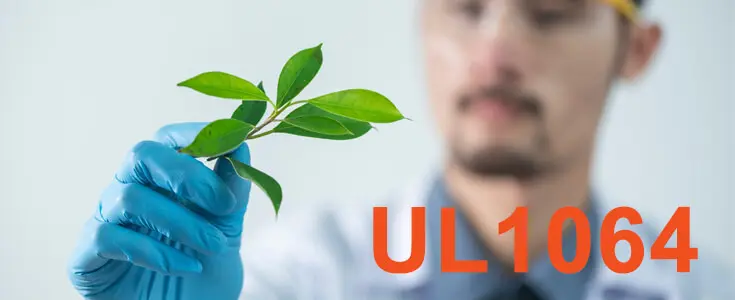
© 2002 - 2025 LiPol Battery Co., Ltd. All Rights Reserved
